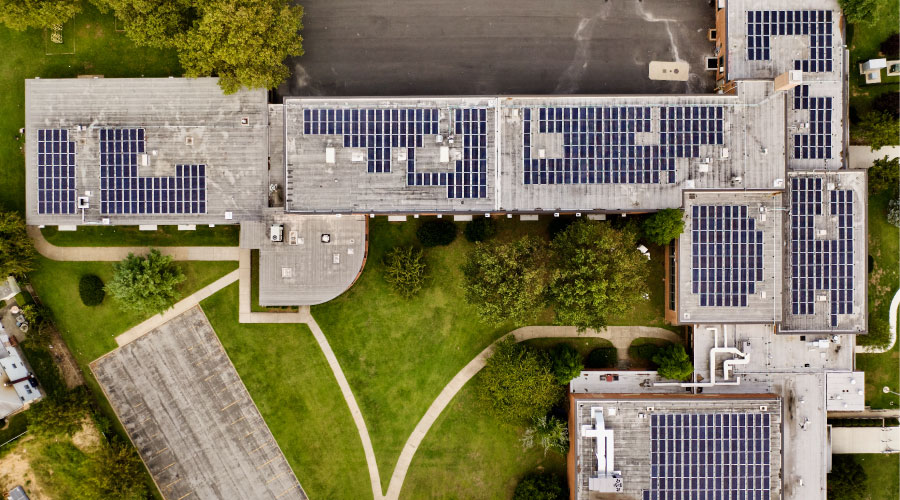Reflectivity, Emissivity Important Factors When Selecting A Cool Roof
Ben Franklin conducted the first reflectivity test in the 1760s. He took different colored swatches of fabric — from dark to light — and placed them in the Philadelphia snow. As the sun beat down Franklin noted that the snow melted around the dark colored fabric quicker than it did underneath the lighter colors. Clearly, the white fabric reflected the sun's rays and maintained a cooler surface temperature than did the darker fabric.
This principle is the same at work on a cool roof. And for that reason, facility managers have been using light colored roofs for decades to keep their roof temperature low and reduce cooling costs during the hot summer months. In fact, cool roofs have become a part of many building codes and voluntary green building rating systems like LEED. But selecting the right cool roof for a facility means understanding exactly how a cool roof works, as well as a number of considerations regarding the selection of a system.
1. Reflectivity
Reflectivity ratings are based on the roof surface's ability to reflect rays from the sun. Reflectivity is expressed as either a percentage of the sun's rays reflected, or the decimal equivalent of that percentage. A cool roof generally has a reflectivity higher than 65 percent, or .65. Reflective surfaces help keep a building cool during the summer, decreasing the cooling load and saving energy. The greatest benefit of reflectivity will be seen in warm climates, where cooling is required throughout most of the year.
2. Emissivity
Emissivity is the ability of a roof to re-radiate any energy absorbed back to the sky. It is expressed as a decimal, with an emissivity closer to 1.0 denoting a surface that re-radiates a majority of its absorbed energy. A roof with a high reflectivity value and a high emissivity value is best suited to save cooling energy during the warm summer months. High emissivity value is also important for reducing the urban heat island effect.
3. Urban Heat Island Effect
According to Hashem Akbari, a researcher on the effects of urban heat islands at Lawrence Berkeley National Laboratories, "black surfaces in the sun can become up to 70 degrees F (40 C) hotter than most reflective white surfaces." In urban areas, the effect of heat absorbent roofs and black pavement can make the temperature 6 to 8 degrees F higher than the surrounding suburban areas. This higher temperature increases smog and raises cooling bills.
4. Energy Savings
The U.S. Environmental Protection Agency and the Lawrence Berkeley Heat Island Group did a study comparing light colored roofs and dark colored roofs. Their research showed that cool roofs can save significant energy. The study analyzed the energy saving potential of light colored roofs in 11 metropolitan areas throughout the United States.
According to Akbari, the estimated savings could be as much $175 million per year for the 11 cities. The extrapolated national energy savings were about $750 million per year.
The Heat Island Group conducted a similar test in Sacramento, Calif. Akbari says that the study found that buildings with light colored roofs "used up to 40 percent less energy for cooling than buildings with darker roofs."
This was consistent with a separate study conducted by the Florida Solar Energy Center, which also found cooling energy costs to be 40 percent lower for light colored roofs. "Cool roofs lower roof surface temperatures, reducing the need for cooling energy in conditioned buildings and making unconditioned buildings more comfortable," says Akbari.
5. Codes and Standards
Reflectivity and emissivity ratings have worked their way into the LEED rating system as well as some state and local building codes. California's Title 24, for example, includes language that specifies cool roofs. Other states, like Georgia and Texas, and some municipalities, like Chicago, have followed suit.
There are currently no mandatory national code regulations regarding minimum reflectivity values for low-slope roof systems. But a recently developed standard — American Society for Heating, Refrigeration and Air-Conditioning Engineers (ASHRAE) standard 189.1, "Standard for the Design of High Performance Green Buildings" — may provide a national template for cool roofing requirements. The standard, which is intended as a model green building code, covers site location, energy use, recycling, water efficiency, indoor air quality, materials, resources and a building's impact on the atmosphere. The code specifies a solar reflective index (SRI) of 78 for cool roofs. SRI is a calculation that combines reflectivity and emissivity into a single metric.
Even if facility managers don't have a mandatory cool roofing code in their area, they still have plenty of resources for guidance. Voluntary labeling programs and rating systems such as LEED and Energy Star are being used more frequently. LEED for New Construction specifies an SRI of 78 for cool roofs.
To achieve the Energy Star label, a low-slope roof (pitch of less than 2:12) must achieve an initial reflectivity rating of .65. After three years, it must still be able to achieve a reflectivity of .50.
Related Topics:












